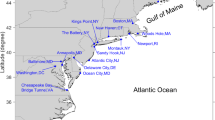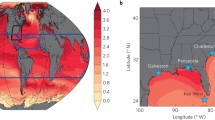Abstract
Water resource management in South Florida faces nearly intractable problems, in part due to weather and climate variability. Rising sea level and coastal storm surge are two phenomena with significant impacts on natural systems, fresh water supplies and flood drainage capability. However, decision support information regarding management of water resources in response to storm surge is not well developed. In an effort to address this need we analyze long term tidal records from Key West, Pensacola and Mayport Florida to extract surge distributions, to which we apply a nonlinear eustatic sea level rise model to project storm surge return levels and periods. Examination of climate connections reveals a statistically significant dependence between surge distributions and the Atlantic Multidecadal Oscillation (AMO). Based on a recent probabilistic model for AMO phase changes, we develop AMO-dependent surge distributions. These AMO-dependent surge projections are used to examine the flood control response of a coastal water management structure as an example of how climate dependent water resource forcings can be used in the formulation of decision support tools.
Similar content being viewed by others
References
Anthoff D, Nicholls RJ, Tol RSJ (2010) The economic impact of substantial sea-level rise. Mitig Adapt Strateg Glob Change 15:321–335. doi:10.1007/s11027-010-9220-7
Araujo I, Pugh DT (2008) Sea levels at Newlyn 1915–2005: analysis of trends for future flooding risks. J Coast Res 24:203–212
Bender MA, Knutson TR, Tuleya RE, Sirutis JJ, Vecchi GA, Garner ST, Held IM (2010) Modeled impact of anthropogenic warming on the frequency of intense Atlantic hurricanes. Science 327:454–458. doi:10.1126/science.1180568
Bindoff NL, Willebrand J, Artale V, Cazenave A, Gregory J, Gulev S, Hanawa K, Le Quéré C, Levitus S, Nojiri Y, Shum CK, Talley LD, Unnikrishnan A (2007) Observations: oceanic climate change and sea level. In: Solomon S, Qin D, Manning M, Chen Z, Marquis M, Averyt KB, Tignor M, Miller HL (eds) Climate change 2007: the physical science basis. Contribution of Working Group I to the Fourth Assessment Report of the Intergovernmental Panel on Climate Change. Cambridge University Press, Cambridge, United Kingdom and New York, NY, USA
Bromirski PD, Flick RE, Cayan DR (2003) Storminess variability along the California Coast: 18585–2000. J Climate 16:982–993
Coles S (2001) An introduction to statistical modeling of extreme values. Springer, New York. ISBN 1-85233-459-2
Enfield DB, Cid-Serrano L (2006) Projecting the risk of future climate shifts. Int J Climatol 26(7):885–895. doi:10.1002/joc.1293
Enfield DB, Cid-Serrano L (2010) Secular and multidecadal warmings in the North Atlantic and their relationships with major hurricane activity. Int J Climatol 30(2):174–184. doi:10.1002/joc.1881
FASS (2010) First America spatial solutions, 2010 first American storm surge report residential storm surge exposure estimates for 13 U.S. Cities. http://www.faspatial.com/storm-surge. Accessed 26 July 2010
Goldenberg SB, Landsea CW, Mestas-Nunez AM, Gray WM (2001) The recent increase in Atlantic hurricane activity: causes and implications. Science 293:474–479
Gray ST, Graumlich JL, Betancourt JL, Pederson GT (2004) A tree-ring based reconstruction of the Atlantic multidecadal oscillation since 1567 A.D. Geophys Res Lett 31:L12205. doi:10.1029/2004GL019932
Haigh I, Nicholls R, Wells N (2010) Assessing changes in extreme sea levels: application to the English Channel, 1900–2006. Cont Shelf Res 30(9):1042–1055. doi:10.1016/j.csr.2010.02.002
Harris DL (1963) Characteristics of the hurricane storm surge. U.S. Dept. of Commerce, Weather Bureau, Technical Paper No. 48, Washington, DC
Hunter J (2009) Estimating sea-level extremes under conditions of uncertain sea-level rise. Climatic Change 99:331–350. doi:10.1007/s10584-009-9671-6
Kerr RA (2000) A North Atlantic climate pacemaker for the centuries. Science 288:1984–1986
Liu Y, Weisberg RH (2007) Ocean currents and sea surface heights estimated across the West Florida Shelf. J Phys Oceanogr 37(6):1697–1713. doi:10.1175/JPO3083.1
Liu JC, Lence BJ, Isaacson M (2010) Direct joint probability method for estimating extreme sea levels. J Wtrwy Port Coast Oc Engrg 136(1):66–76. doi:10.1061/ASCE0733-950X(2010)136:1(66)
Mousavi ME, Irish JL, Frey AE, Olivera F, Edge BL (2010) Global warming and hurricanes: the potential impact of hurricane intensification and sea level rise on coastal flooding. Climatic Change 104:783–801. doi:10.1007/s10584-009-9790-0
NOAA (2009a) National Oceanic and Atmospheric Administration, National Ocean Service (NOS) Center for Operational Oceanographic Products and Services (CO-OPS). http://tidesandcurrents.noaa.gov/geo.shtml?location=8724580, http://tidesandcurrents.noaa.gov/geo.shtml?location=8729840, http://tidesandcurrents.noaa.gov/geo.shtml?location=8720220. Accessed 10 May 2010
NOAA (2009b) National Oceanic and Atmospheric Administration Linear mean sea level (MSL) trends and 95% confidence intervals in mm/yr (2009a). http://tidesandcurrents.noaa.gov/sltrends/msltrendstable.htm. Accessed 14 May 2010
NOAA (2009c) National Oceanic and Atmospheric Administration, Earth System Research Laboratory, Climate Timeseries AMO (Atlantic Multidecadal Oscillation) Index. http://www.esrl.noaa.gov/psd//data/timeseries/AMO/. Accessed 30 July 2010
NRC (1987) National Research Council, Responding to Changes in Sea Level: Engineering Implications. National Academy Press: Washington, D.C. http://www.nap.edu/catalog.php?record_id=1006. Accessed 21 May 2010
Park J, Obeysekera J, Irizarry-Ortiz M, Barnes J, Park-Said W (2010) Climate links and variability of extreme sea level events at key west, Pensacola, and Mayport Florida. J Wtrwy, Port, Coast, Oc Engrg 136:350–356. doi:10.1061/(ASCE)WW.1943-5460.0000052. Accessed 12 May 2010
Parker GG, Ferguson GE, Love SK et al (1955) Water resources of Southeastern Florida. United States Department of the Interior, Geological Survey, Water-Supply Paper 1255, United States Government Printing Office, Washington, 1955. http://sofia.usgs.gov/publications/papers/wsp1255/. Accessed 8 December 2009
R Development Core Team (2008) R: A language and environment for statistical computing, R Foundation for Statistical Computing, Vienna, Austria. ISBN 3-900051-07-0. http://www.R-project.org. Accessed 22 October 2009
Rittel HWJ, Webber MM (1973) Dilemmas in a general theory of planning. Policy Sci 4(2):155–169
Seymour R (1996) Wave climate variability in Southern California. J Wtrwy Port Coast Oc Engrg 122:182–186
SFWMD (2009) Climate Change and Water Management in South Florida, Interdepartmental Climate Change Group, South Florida Water Management District (SFWMD), November 12, 2009, 3301 Gun Club Road West Palm Beach, Florida. https://my.sfwmd.gov/portal/page/portal/xrepository/sfwmd_repository_pdf/climate_change_and_water_management_in_sflorida_12nov2009.pdf. Accessed 23 May 2010
SFWMD (2010) Operational Planning resource webpage, South Florida Water Management District. http://www.my.sfwmd.gov/portal/page/portal/xweb%20-%20release%202/operational%20planning. Accessed 23 May 2010
Stephenson A (2009) Package ‘evd’, Functions for extreme value distributions. http://www.cran.r-project.org/web/packages/evd/evd.pdf. Accessed 12 May 2010
USACE (2009) Water Resource Policies and Authorities Incorporating Sea-Level Change Considerations in Civil Works Programs, Department of the Army Engineering Circular No. 1165-2-211 1 July 2009, U.S. Army Corps of Engineers, CECW-CE Washington, DC 20314-1000
Wang C, Lee S-K, Enfield DB (2008) Climate response to anomalously large and small Atlantic warm pools during the summer. J Climate 21:2437–2450. doi:10.1175/2007JCLI2029.1
Woodworth PL, White NJ, Jevrejeva S, Holgate SJ, Church JA, Gehrelsd WR (2009) Evidence for the accelerations of sea level on multi-decade and century timescales. Int J Climatol 29:777–789. doi:10.1002/joc.1771
Woodworth PL, Blackman DL (2004) Evidence for systematic changes in extreme high waters since the mid-1970s. J Clim 17:1190–1197
Woodworth PL, Blackman DL (2002) Changes in extreme high waters at Liverpool since 1768. Int J Climatol 22:697–714. doi:10.1002/joc.761
Zhang K, Douglas BC, Leatherman SP (2000) Twentieth-century storm activity along the U.S. East Coast J Climate 13:1748–1761
Author information
Authors and Affiliations
Corresponding author
Rights and permissions
About this article
Cite this article
Park, J., Obeysekera, J., Irizarry, M. et al. Storm surge projections and implications for water management in South Florida. Climatic Change 107, 109–128 (2011). https://doi.org/10.1007/s10584-011-0079-8
Received:
Accepted:
Published:
Issue Date:
DOI: https://doi.org/10.1007/s10584-011-0079-8




